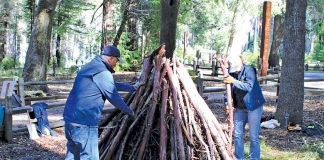For a lot of folks, a good share of their off hours in the next 10 days or so will be spent on travel plans, preparations for entertaining, and the logistics of cooking and serving the traditional Thanksgiving meal.
Although the commercial blitzkrieg surrounding Christmas has seduced people of every stripe, that holiday is — albeit to what many practicing Christians no doubt feel is an increasingly limited extent — a religious observance. The fourth Thursday in November, however, is a holiday for every American. Thanksgiving is a straightforward celebration of life and of where and with whom we are.
The popular concept of Thanksgiving links it to Pilgrims and American Indians at Plymouth Plantation in 1621. It’s a reference that serves a purpose, but the meal shared by the natives and the immigrants on that occasion was actually an autumn harvest observance and a formal “thank you” to the Wampanoag Indians for teaching the skills and practices necessary to get the new arrivals through the coming winter. Fully half of the Pilgrims had died in the winter of 1620, their first in the new country.
During the early period, the colonies would periodically proclaim days of thanksgiving, usually in celebration of good news or a propitious event. Ten years after the celebrated meal at Plymouth Plantation, for example, the Massachusetts Bay Colony declared a day of thanksgiving when an overdue and much-needed supply ship arrived after it had been thought lost at sea.
The Continental Congress issued the first declaration of a national day of thanksgiving in 1777 and continued to do so through 1783, with each declaration specific to the given year and typically falling in December. George Washington picked up the practice in his first year in office: Thursday, Nov. 25, 1789, was the first Thanksgiving Day declared in the new nation. But another was not observed for several years.
Until the Civil War, only the New England area continued to have annual formal harvest observances.
It is Sarah Josepha Hale to whom we owe thanks for the holiday Americans now enjoy. Born and raised in New England, she gained some prominence with an 1827 novel that included two chapters detailing the November thanksgiving traditions of her youth. The following year, she became the first female editor of a national publication in the United States, and for the next 40 years, the highly successful and very influential Lady’s Book Magazine was her platform for a campaign to establish a recurring national day of thanksgiving.
In addition to features and articles in the magazine, she cajoled celebrities to join her cause, lobbied every incumbent U.S. president and wrote letters to governors, ministers and editors. Starting in 1846, she devoted each November issue to the proposed holiday — with recipes, poems and stories depicting idealized family gatherings. In an 1858 editorial, Hale asked the country to “consecrate the day to benevolence of action by sending good gifts to the poor and doing those deeds of charity that will, for one day, make every American home the place of plenty and rejoicing.”
By 1860, 25 of the 31 states had proclaimed annual thanksgiving observances, nearly all stipulating the last Thursday in November. Still, it took the shock of the Civil War and the staggering horror of the battle of Gettysburg in 1863 to turn the tide. Lady’s Book Magazine, containing Hale’s annual editorial calling for a national day of thanksgiving, struck a chord with Americans after that important Union victory, and it was widely circulated. She sent a copy to President Abraham Lincoln, with a personal letter asking that he have the “day of our annual thanksgiving made a National and fixed Union festival.”
On Oct. 3, 1863, Honest Abe did just that, setting the annual observance as the final Thursday in November.
Remarkably, Thanksgiving is still celebrated in the spirit that Ms. Hale and President Lincoln intended. On Friday, the day after Thanksgiving, retailers have managed to institute a national day of spending. But on Thursday, most of us manage to harbor good will, thanks and generosity through cooking and eating and family and football.
And that’s just what Abe and Sarah intended.
Travel conditions put a strain on gratitude
For some, the travel to be with family on Thanksgiving can be a hassle, but once you get there, you’re there, and everything is OK. If you’re in that category, though, get ready for an especially annoying travel experience this year.
The Wednesday before Thanksgiving is typically the busiest travel day of the year, and the days before and after are only marginally better. According to a CBS poll, airline costs are up a shocking 50 percent over last year. But wait, it gets worse — you’ll be crowded, too. The Air Transport Association says 90 percent of all U.S. flights during the Thanksgiving travel period are fully booked already, and most are over-booked. Air travel is forecast to be the heaviest it’s been since 1944, and travelers then didn’t have to deal with interminable security lines and combat in the aisles for overhead storage space.
Driving somewhere? During daylight hours, the freeways will be as crowded as the skies. The weekly AAA gas price survey shows that the cost of a gallon of regular gasoline went up 6 cents last week, making it 9 percent higher than a year ago already, with more increases expected as Thanksgiving gets closer.
Even for those staying home, the holiday often means a lot of food shopping, house cleaning, hours of cooking, and then the drudgery of cleanup.
But in all cases, it’s absolutely worth it. At least for that one day, no matter where we are or what may be on the plate when we sit down to eat, even those in humble conditions understand and feel the spirit of Thanksgiving.
Have a great one, and remember Thanksgiving Day advocate Sarah Josepha’s words about “good gifts to the poor,” “deeds of charity” and, especially, “rejoicing.”
Steve Bailey of Boulder Creek has spent plenty of time in recreational activities.
E-mail him at sb*****@****io.com.










